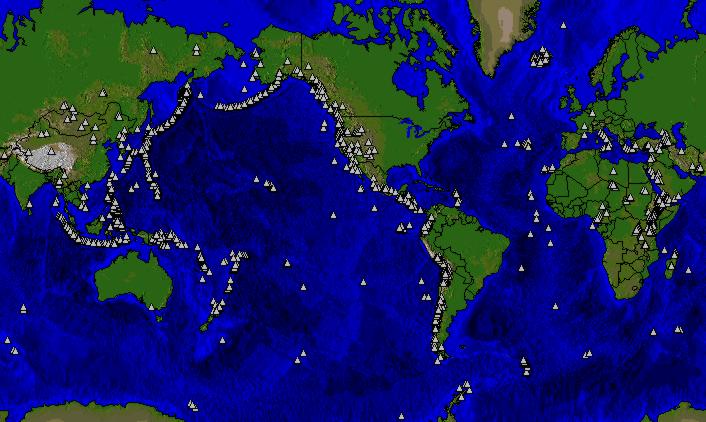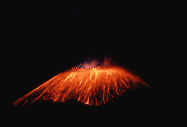 Earth's
Untamed Energy: Earth's
Untamed Energy:
Earthquakes and Volcanoes
We discuss:
Natural HazardsIn this chapter we will focus on the origin of these phenomena and try to get some sense of their inevitability. You will learn that little can be done to remove these threats, but that precaution and anticipation can at least limit the cost of human life. As humans we tend to concentrate on our own well-being, but other forms of life on our planet are equally if not more affected. Since we are all part of a single ecosystem, nature probably has a reason to use these powers occasionally, but such a discussion takes us away from the aim of this chapter. The arrival of a new natural hazard: humans. We now know that we are able to change the face of the Earth. This can be done through the destructive forces of modern warfare, especially nuclear. Operating on a slower timeframe, and therefore seemingly less threatening, are the effects of industrialization and modernization. The production of atmosphere-altering compounds may result in health hazards for all forms of life, as well as changes in global climate patterns that will affect, for example, food production. We should not underestimate the effect of this latest natural hazard--one of the few we can do something about. In later chapters we will return to anthropogenic effects and the companion course, GlobalChange 2, has human interactions as the focus. EarthquakesEarthquakes occur every day! Click here or on map for an interactive site or look below for a map of the most recent earthquakes in the world.
Watching the evening news, we regularly hear the anchorperson announce the latest occurrence of an earthquake somewhere in the world. Commonly this feature is complemented by a note of its magnitude, before turning to the human impact. Somehow the value of this magnitude equates with the scale of this natural disaster, as we only hear about large-magnitude earthquakes. What is the science behind this information? We'll try to figure it out in this chapter. First some sobering statistics below. You can select do your own criteria for past earthquakes through NOAA's Earthquake database. Some Destructive Earthquakes
* Official casualty figure--estimated
death toll as high as 655,000. + Note that these dates are prior
to 1000 AD; no digit is missing.
As we will further explore in plate tectonics, forces in the Earth create an environment where parts of the surface grind past other parts. The boundaries between such moving parts are called faults. It is the catastrophic displacement of a fault that generates an earthquake. Consider a piece of wood. You can bend the wood a little, until it snaps. The ability to bend is an elastic property of a material, and when it snaps you have exceeded its elastic limit. The same applies to geological faults. Rock are only able to accumulate a certain amount of elastic energy, what we call elastic strain energy. When you exceed this energy, the rock breaks, much like a ceramic plate breaks when it hits the floor. In the case of preexisting faults, the strength of the rock is even less, and displacement will occur regularly. These displacements can be gradually or intermittently. In the former case we speak of aseismic slip, while in the latter case the displacement is seismic. The moment of seismic slip, after the maximum strain energy is stored, is the origin of an earthquake. The more energy released, the greater the earthquake magnitude. Before turning to the details of locating earthquakes and determining their magnitude, we need to establish two terms. The location of an earthquake in the Earth, where the actual strain energy release occurs, is called the focus of an earthquake. The point at the surface straight above the focus is called the epicenter. Practically, the epicenter is most important for societal impact, as it marks the position where energy release, and thus shaking, is largest. The position of maximum energy release is actually the focus, but if this region lies deep in the Earth, say 500 kilometers, the effect at the surface may be minor. Intensity The effect of an earthquake on the Earth's surface is called the intensity. The intensity scale consists of a series of certain key responses such as people awakening, movement of furniture, damage to chimneys, and finally - total destruction. Although numerous intensity scales have been developed over the last several hundred years to evaluate the effects of earthquakes, the one currently used in the United States is the Modified Mercalli (MM) Intensity Scale. It was developed in 1931 by the American seismologists Harry Wood and Frank Neumann. This scale, composed of 12 increasing levels of intensity that range from imperceptible shaking to catastrophic destruction, is designated by Roman numerals. It does not have a mathematical basis; instead it is an arbitrary ranking based on observed effects. The Modified Mercalli Intensity value assigned to a specific site after an earthquake has a more meaningful measure of severity to the nonscientist than the magnitude because intensity refers to the effects actually experienced at that place. After the occurrence of widely felt earthquakes, the Geological Survey mails questionnaires to postmasters in the disturbed area requesting the information so that intensity values can be assigned. The results of this postal canvass and information furnished by other sources are used to assign an intensity within the felt area. The maximum observed intensity generally occurs near the epicenter. The lower numbers of the intensity scale generally deal with the manner in which the earthquake is felt by people. The higher numbers of the scale are based on observed structural damage. Structural engineers usually contribute information for assigning intensity values of VIII or above. The following is an abbreviated description
of the 12 levels of the Modified Mercalli intensity scale.
The increase in the degree of surface shaking (intensity) for each unit increase of magnitude of a shallow crustal earthquake is unknown. Intensity is based on an earthquake's local accelerations and how long these persist. Intensity and magnitude thus both depend on many variables that include exactly how rock breaks and how energy travels from an earthquake to a receiver. These factors make it difficult for engineers and others who use earthquake intensity and magnitude data to evaluate the error bounds that may exist for their particular applications. An example of how local soil conditions can greatly influence local intensity is given by catastrophic damage in Mexico City from the 1985, magnitude 8.1 earthquake centered some 300 km away. Resonance of the soil-filled basin under parts of Mexico City amplified ground motions for periods of 2 seconds by a factor of 75 times. This shaking led to selective damage to buildings 15 - 25 stories high (same resonance period), resulting in major building losses and at least 8,000 fatalities. Earthquake Location and Magnitude Earthquakes range broadly in size,
from meter-scale fracturing of rocks to major earthquakes such as the 1965
Rat Island earthquake in the Aleutian arc that involved a 650 kilometer
length of the Earth's crust. We record earthquake activity through seismometers,
which are devices that measure the Earth's sudden movement. The classic
image of a pen that writes a seismogram has been replaced by digital systems,
but the principle remains the same. The greater the earthquake, the
greater the shaking at the Earth's surface. Let's look at a typical
seismogram (Figure). You will notice that there are times of wide swings
of the recorder against a background of small amplitude. Amplitude
is the technical term for the distance between the average background and
the maximum swing of the needle. The pattern falls into two components:
an initial series of swings followed by slowly diminishing activity, then
a second wave of greater amplitude. If the station is sufficiently
close to the earthquake source region, we find that the needle continues
to move even after this second wave of activity. These pulses of
activity record different types of waves that emanate from an earthquake.
Those arriving first are called P-waves, for Primary waves, whereas the
second pulse of waves are predictably called S-waves. Based on these
two waves, the location and magnitude can be determined. Earthquakes range broadly in size,
from meter-scale fracturing of rocks to major earthquakes such as the 1965
Rat Island earthquake in the Aleutian arc that involved a 650 kilometer
length of the Earth's crust. We record earthquake activity through seismometers,
which are devices that measure the Earth's sudden movement. The classic
image of a pen that writes a seismogram has been replaced by digital systems,
but the principle remains the same. The greater the earthquake, the
greater the shaking at the Earth's surface. Let's look at a typical
seismogram (Figure). You will notice that there are times of wide swings
of the recorder against a background of small amplitude. Amplitude
is the technical term for the distance between the average background and
the maximum swing of the needle. The pattern falls into two components:
an initial series of swings followed by slowly diminishing activity, then
a second wave of greater amplitude. If the station is sufficiently
close to the earthquake source region, we find that the needle continues
to move even after this second wave of activity. These pulses of
activity record different types of waves that emanate from an earthquake.
Those arriving first are called P-waves, for Primary waves, whereas the
second pulse of waves are predictably called S-waves. Based on these
two waves, the location and magnitude can be determined.
Location P- and S-waves represent different atomic interactions in materials. P-waves briefly compress neighboring atoms, after which they relax and transfer the energy to neighboring atoms. S-waves represent a brief shear motion between atoms, which relaxes and is passed on. The critical consequence for the purpose of earthquake location is that the velocity at which P and S waves travel differs. P-waves move faster than S-waves (hence P and S!). So, if the distance of the earthquake to the recording station increases, the time between the arrival of P- and S-waves will increase. From this P-S travel time difference we can determine the distance of the earthquake to the seismometer. Note that we only get the distance, not the direction of the earthquake focus. The solution is to determine the distance for more than one seismic station, and draw this on a map. Two determinations result in two possible locations (two overlapping circles have two points in common). Three or more determinations can only have one location in common. This location is called the epicenter.
Modern seismographic systems precisely amplify and record ground motion (typically at periods of between 0.1 and 100 seconds) as a function of time. This amplification and recording as a function of time is the source of instrumental amplitude and arrival-time data on near and distant earthquakes. In the 1930's, Charles F. Richter introduced the concept of earthquake magnitude. His original definition held only for California earthquakes occurring within 600 km of a particular type of seismograph (the Woods-Anderson torsion instrument). His basic idea was quite simple: by knowing the distance from a seismograph to an earthquake and observing the maximum signal amplitude recorded on the seismograph, an empirical quantitative ranking of the earthquake's inherent size could be made. Most California earthquakes occur within ~15 km of the surface, so, to a first approximation, corrections for variations in earthquake focal depth were therefore unnecessary. Richter's original magnitude scale (ML) was then extended to observations of earthquakes of any distance, with focal depths ranging between 0 and 700 km. Because earthquakes generate body waves, which travel into and through the Earth, as well as surface waves, which travel through Earth's uppermost layers, two magnitude scales evolved: the mb and MS scales. The body-wave magnitude formula is: mb = log10(A/T) + Q(D,h) , where A is the amplitude of ground motion (in microns); T is the corresponding period (in seconds); and Q(D,h) is a correction factor that is a function of distance, D (degrees), between epicenter and station and focal depth, h (in kilometers), of the earthquake. The surface-wave formula is: MS = log10 (A/T) + 1.66 log10 (D) + 3.30 . There are many variations of these formulas that take into account effects of specific geographic regions, so that the final computed magnitude is reasonably consistent with Richter's original definition of ML. A rough idea of frequency of occurrence of large earthquakes is given by the following figure:
When initially developed, these magnitude scales were considered to be equivalent; in other words, earthquakes of all sizes were thought to radiate fixed proportions of energy at different periods. But it turns out that larger earthquakes, which have larger rupture surfaces, systematically radiate more long-period energy. Thus, for very large earthquakes, body-wave magnitudes badly underestimate true earthquake size; the maximum body-wave magnitudes are about 6.5 - 6.8. In fact, the surface-wave magnitudes underestimate the size of very large earthquakes; the maximum observed values are about 8.3 - 8.7. Some investigators have suggested that the 100 s mantle Love waves (a type of surface wave) should be used to estimate magnitude of great earthquakes. However, even this approach ignores the fact that damage to structure is often caused by energy at shorter periods. Thus, modern seismologists use another parameters to describe the physical effects of an earthquake: radiated energy. Energy The amount of energy radiated by an earthquake is a measure of the potential for damage. Estimates of energy have historically relied on the empirical relationship developed by Beno Gutenberg and Charles Richter: log10E = 11.8 + 1.5MS where energy, E, is expressed in ergs. With the worldwide deployment of digitally recording seismographs with broad bandwidth response, computerized methods are now able to make accurate and explicit estimates of energy on a routine basis for all major earthquakes. A magnitude based on energy radiated by an earthquake, Me, can now be defined as: Me = 2/3 log10E - 9.9 . Comparing earthquake magnitude and energy released:
For example, a magnitude 7.2 earthquake produces 10 times more ground motion that a magnitude 6.2 earthquake, but it releases about 32 times more energy. The energy release best indicates the destructive power of an earthquake. Earthquake DepthEarthquakes can occur anywhere between the Earth's surface and about 700 kilometers below the surface. For scientific purposes, this earthquake depth range of 0 - 700 km is divided into three zones: shallow, intermediate, and deep. Shallow earthquakes are between 0 and 70 km deep; intermediate earthquakes, 70 - 300 km deep; and deep earthquakes, 300 - 700 km deep. In general, the term "deep-focus earthquakes" is applied to earthquakes deeper than 70 km. All earthquakes deeper than 70 km are localized within slabs of lithosphere that are sinking into the Earth's mantle.The most obvious indication on a seismogram that a large earthquake has a deep focus is the small amplitude, or height, of the recorded surface waves. Although the surface-wave pattern does generally indicate that an earthquake is either shallow or may have some depth, the most accurate method of determining the focal depth of an earthquake is to read a depth phase recorded on the seismogram. The depth phase is the characteristic phase pP, which is a P wave that is reflected from the surface of the Earth at a point relatively near the hypocenter. At distant seismograph stations, the pP follows the P wave by a time interval that changes slowly with distance but rapidly with depth. This time interval, pP-P (pP minus P), is used to compute depth-of-focus tables. Using the time difference of pP-P as read from the seismogram and the distance between the epicenter and the seismograph station, the depth of the earthquake can be determined from published travel-time curves or depth tables. Earthquake MonitoringScientists study the past frequency of large earthquakes in order to determine the future likelihood of similar large shocks. For example, if a region has experienced four magnitude 7 or larger earthquakes during 200 years of recorded history, and if these shocks occurred randomly in time, then scientists would assign a 50 percent probability (that is, just as likely to happen as not to happen) to the occurrence of another magnitude 7 or larger quake in the region during the next 50 years.But in many places, the assumption of random occurrence with time may not be true, because when strain is released along one part of the fault system, it may actually increase on another part. Four magnitude 6.8 or larger earthquakes and many magnitude 6 - 6.5 shocks occurred in the San Francisco Bay region during the 75 years between 1836 and 1911. For the next 68 years (until 1979), no earthquakes of magnitude 6 or larger occurred in the region. Beginning with a magnitude 6.0 shock in 1979, the earthquake activity in the region increased dramatically; between 1979 and 1989, there were four magnitude 6 or greater earthquakes, including the magnitude 7.1 Loma Prieta earthquake. This clustering of earthquakes leads scientists to estimate that the probability of a magnitude 6.8 or larger earthquake occurring during the next 30 years in the San Francisco Bay region is about 67 percent (twice as likely as not). Another way to estimate the likelihood of future earthquakes is to study how fast strain accumulates. When plate movements build the strain in rocks to a critical level, like pulling a rubber band too tight, the rocks will suddenly break and slip to a new position. Scientists measure how much strain accumulates along a fault segment each year, how much time has passed since the last earthquake along the segment, and how much strain was released in the last earthquake. This information is then used to calculate the time required for the accumulating strain to build to the level that results in an earthquake. This simple model is complicated by the fact that such detailed information about faults is rare. In the United States, only the San Andreas fault system has adequate records for using this prediction method. Both of these methods, and a wide array of monitoring techniques, are being tested along part of the San Andres fault. For the past 150 years, earthquakes of about magnitude 6 have occurred an average of every 22 years on the San Andreas fault near Parkfield, California. The last shock was in 1966. Because of the consistency and similarity of these earthquakes, scientists have started an experiment to "capture" the next Parkfield earthquake. A dense web of monitoring instruments was deployed in the region during the late 1980s. The main goals of the ongoing Parkfield Earthquake Prediction Experiment are to record the geophysical signals before and after the expected earthquake; to issue a short-term prediction; and to develop effective methods of communication between earthquake scientists and community officials responsible for disaster response and mitigation. This project has already made important contributions to both earth science and public policy. Information on the recent earthquakes (including time, location, magnitude and maps): http://neic.usgs.gov/neis/qed http://earthquake.usgs.gov/earthquakes/world/seismicity/ http://pubs.usgs.gov/gip/earthq1 Volcanoes Volcanoes generate a wide variety of phenomena that can alter the Earth's
surface and atmosphere and endanger people and property. Small events may
pose hazards only within a few miles of a volcano, while large events can
directly or indirectly endanger people and property tens to hundreds of
miles away. First we'll explore the origin of magma and then we'll look
at some eruptive types and associated hazards. Volcanoes generate a wide variety of phenomena that can alter the Earth's
surface and atmosphere and endanger people and property. Small events may
pose hazards only within a few miles of a volcano, while large events can
directly or indirectly endanger people and property tens to hundreds of
miles away. First we'll explore the origin of magma and then we'll look
at some eruptive types and associated hazards.
Go to VolcanoWorld's interactive site to see currently active volcanoes. Some linked sites offer webcams that show real-time images of eruption (or sleeping) volcanoes. You can search NOAA's Volcano database using your favorite criteria. Magma formation When going deeper into Earth, the temperature (and pressure) increase. This change is called the geothermal gradient. At first it increases by 20-30C/km, but below 15 km the increase is less. At the crust-mantle boundary (~40 km depth), the temperature is 700-800C, whereas at the core-mantle boundary the temperature is about 4000C (hot enough to melt iron). You will recall that temperature increase can change the state of matter from solid to liquid to gas. But pressure opposes this progression, such that increasing pressure will tend to keep matter in its most dense (=solid) form. The widespread presence of active volcanism and extrusive rocks tell us that there must be molten rock hidden in the Earth. Do not think that there is a sea of lava somewhere below the surface, but in places the condition are just right to make liquids (and gases). How does this happen?
What happens when heating a solid that starts at 100 km depth and 500C? When it reaches the solidus, at ~1300C, the rock will melt. So, melting occurs when we add heat. Perhaps surprisingly, a rock at, say, 500 km depth and 1500C will be able to melt when we reduce the pressure. So, bringing hot rocks closer to the surface can create melts without a corresponding temperature increase. Recall that pressure resists expansion, i.e. melting. Lastly, a dashed line is shown in the P-T diagram, which represent the solidus for peridotite with a few percent water in the rock. The presence of water lowers the melting temperature of rocks, which relates to the nature of weakened atomic bonds in minerals with water. So, introducing H2O can cause melting, while P and T remain unchanged. In summary, there are three ways to create melts: heating, depressurizing and water introduction. Distribution of the World's Volcanoes. Click here to open an interactive site at the Smithsonian to learn more about regional volcanism and individual volcanoes
When we look at the location of Earth's
~500 active volcanoes around the world, we find that they occur
in selected regions and that these regions characteristically reflect the
activity of one of the melting mechanisms. Hawaii is an example of heating,
Iceland in the North Atlantic Ocean is an example of depressurizing, and
the South American Andes result from water addition. Later we'll see that
these three mechanisms relate beautifully to the nature of plate margins.
For now we close this section with a look at some volcanic hazards and
a brief mention of monitoring efforts of volcanic activity.
MonitoringThe most common methods to study volcanic activity are measurement of changes in the shape of the volcano, determination of the location and magnitude of earthquakes, and measurement of changes in volcanic-gas composition and magnetic field.Measurement of changes in the
shape of a volcano
Precise determination of the
location and magnitude of earthquakes by a well-designed seismic network
Measurement of changes in volcanic-gas
composition and in magnetic field
SummaryEarthquakes can be categorized according to their location (focus & epicenter), intensity, magnitude, and energy. Seismic waves are created by the release of energy stored in rocks. The speed at which different types of seismic waves travel can be used to determine the epicenter of an earthquake.Volcanoes erupt as a result of high-pressure gas and magma below the surface of the Earth. The magma forms through heating, depressurizing, and water introduction. Eruptions of volcanoes produce pyroclastic flows, lava flows, debris flows, and landslides. Although these natural disasters
have been studied extensively and their causes are well-understood, predicting
such events over short time scales remains difficult.
Self Test Take the NOAA's Natural Hazards Quiz.
Copyright University of Michigan unless indicated otherwise. |
|||||||||||||||||||||||||||||||||||||||||||||||||||||||||||||||||||||||||||||||||||||||||||||||||||||||||||||||||||||||||||||||||||||||||||||||||||||||||||||||||||||||||||||||||||||||||


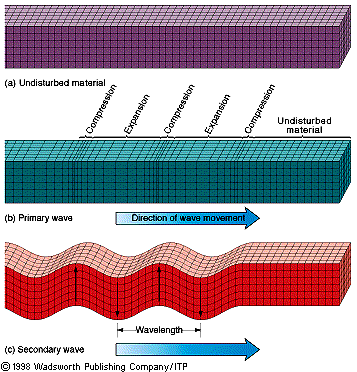

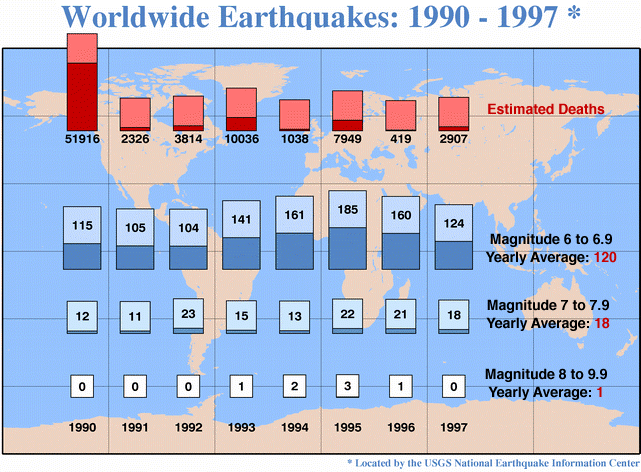
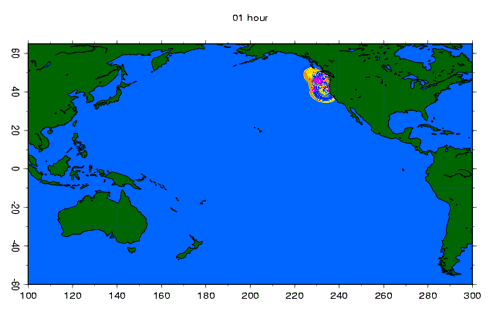 Tsunami
model
Tsunami
model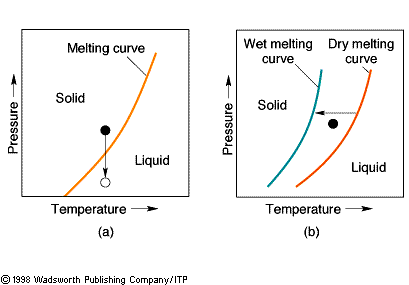 We'll
illustrate the principle in a schematic diagram that plots the stability
fields of solid and liquid for a representative mantle rock (say, a peridotite,
which is an olivine-rich rock). The solidus, the line that separates solid
from liquid has a positive slope; i.e., larger pressures require larger
temperatures for melting to occur. In order to translate this P-T diagram
to the Earth, you need to know that pressure increases with depth by the
following equation: P = density x gravity x depth. Taking a representative
upper mantle density of 2900 kg*m-3 gives a pressure increase
per km of: 2900 x 9.8 x 1000 = 28 x 106 Pa = 28 MPa (280 bar). Thus at
~40 km depth, the corresponding pressure is > 1 GPa.
We'll
illustrate the principle in a schematic diagram that plots the stability
fields of solid and liquid for a representative mantle rock (say, a peridotite,
which is an olivine-rich rock). The solidus, the line that separates solid
from liquid has a positive slope; i.e., larger pressures require larger
temperatures for melting to occur. In order to translate this P-T diagram
to the Earth, you need to know that pressure increases with depth by the
following equation: P = density x gravity x depth. Taking a representative
upper mantle density of 2900 kg*m-3 gives a pressure increase
per km of: 2900 x 9.8 x 1000 = 28 x 106 Pa = 28 MPa (280 bar). Thus at
~40 km depth, the corresponding pressure is > 1 GPa.
